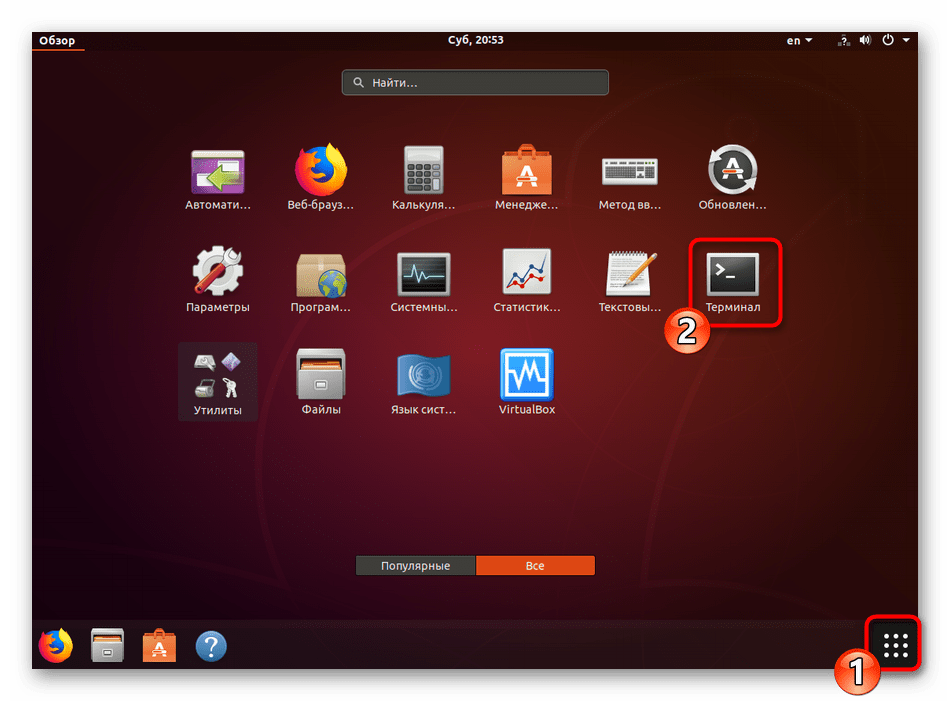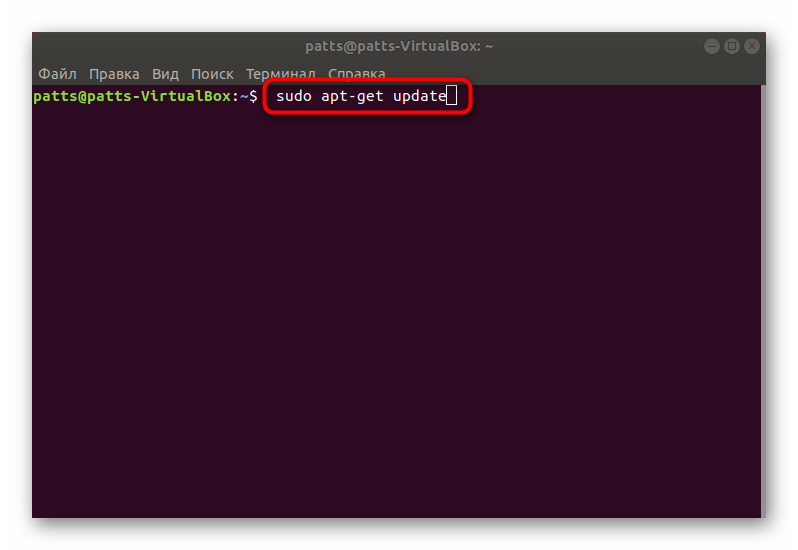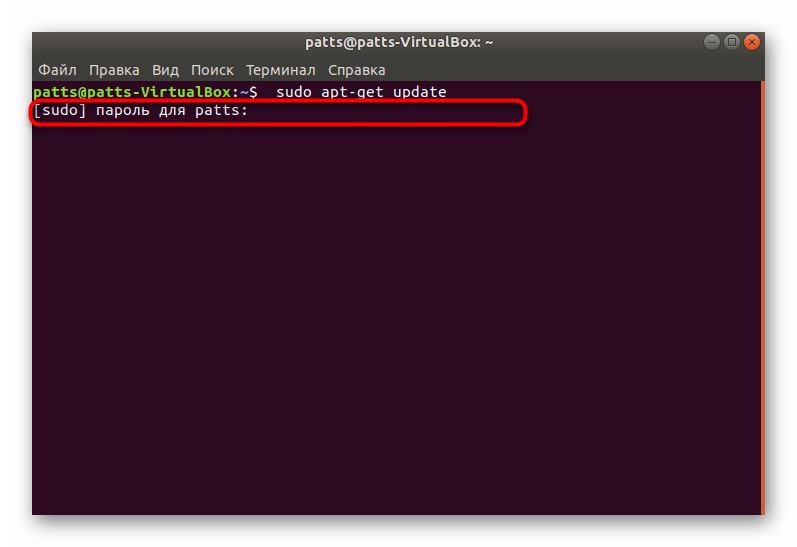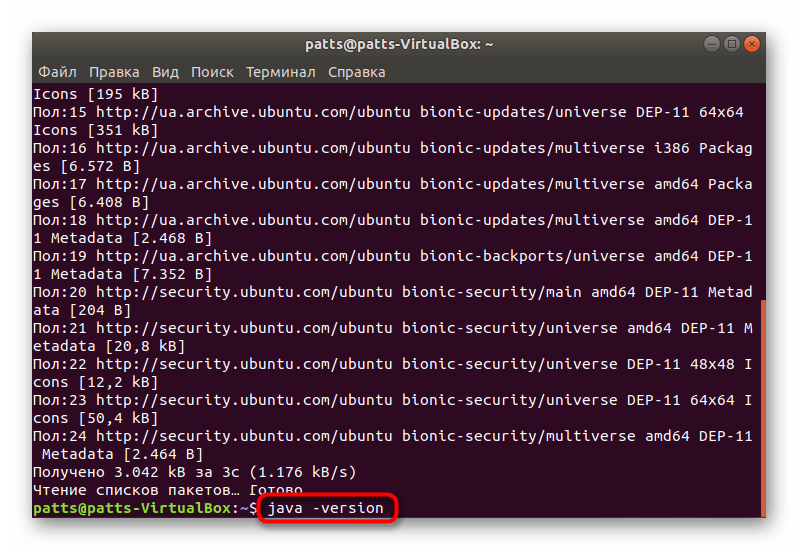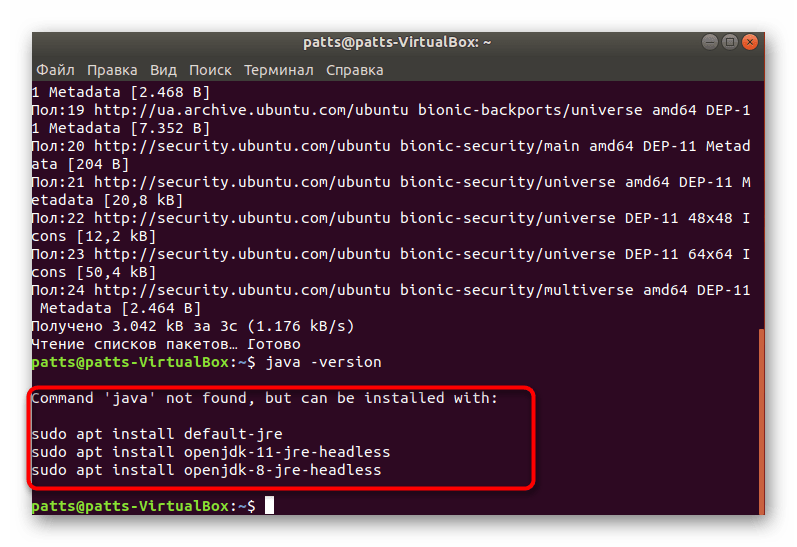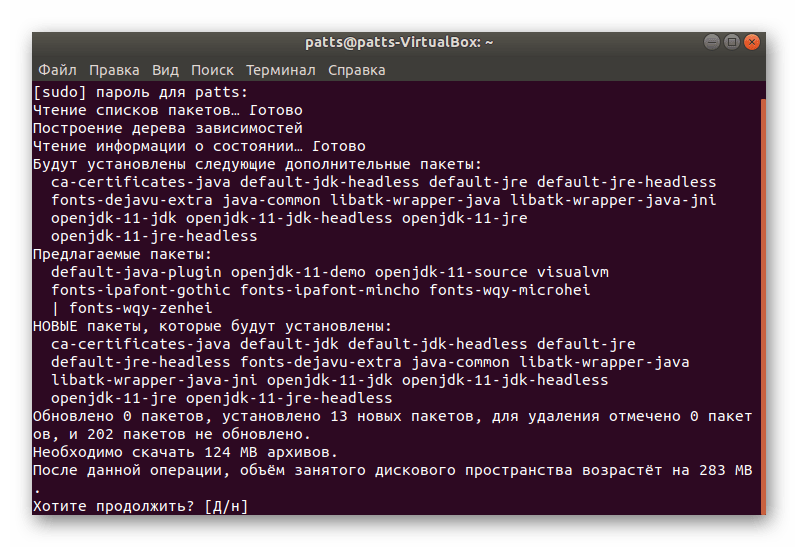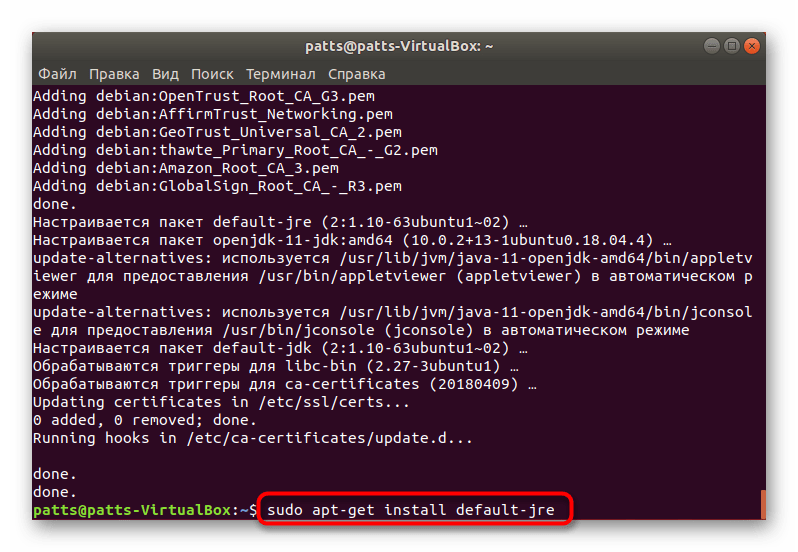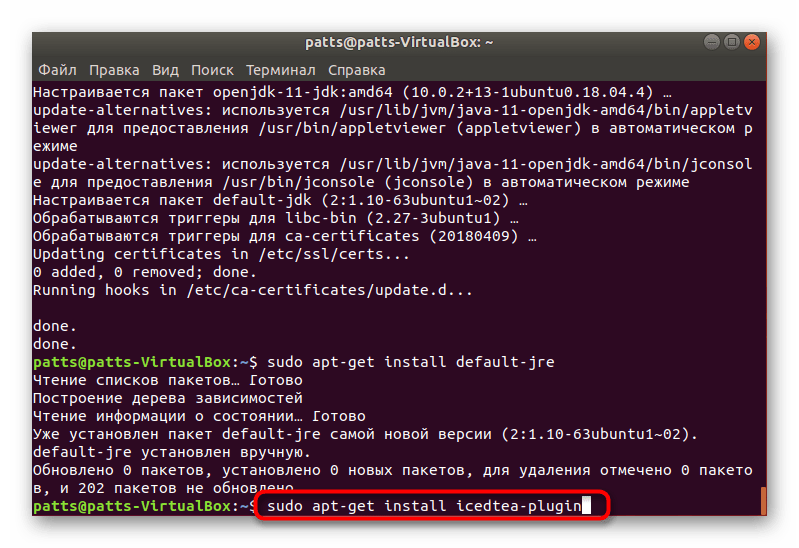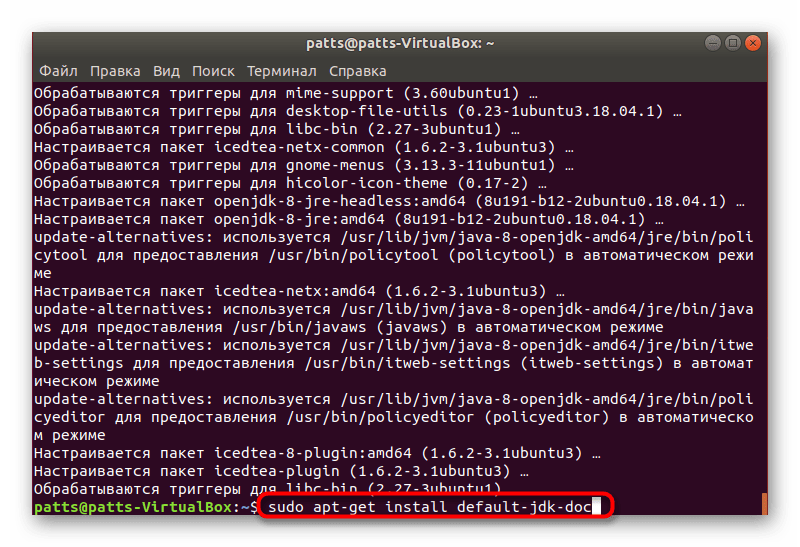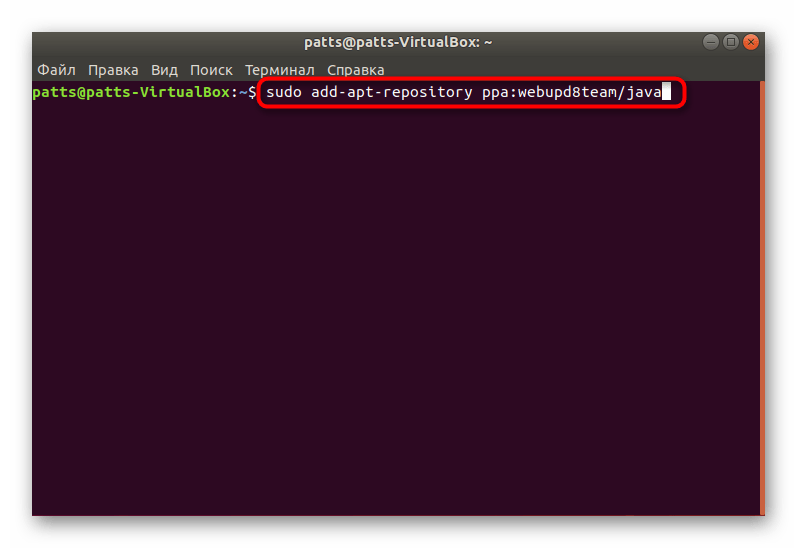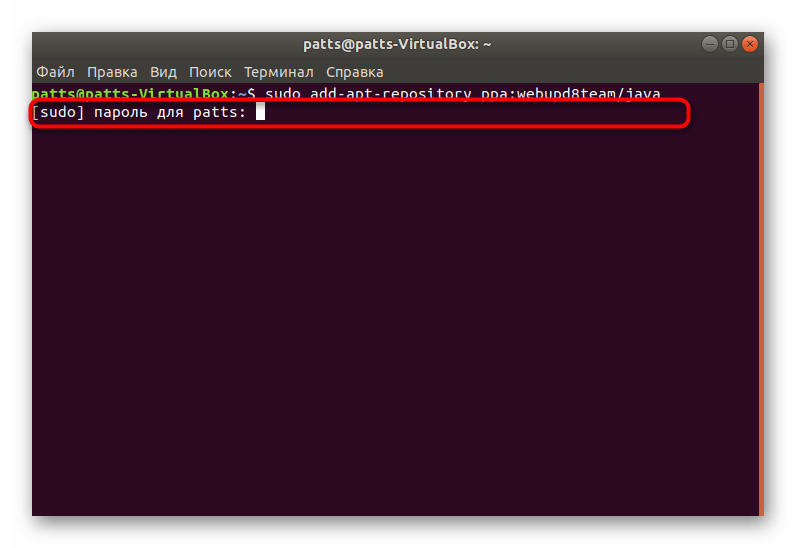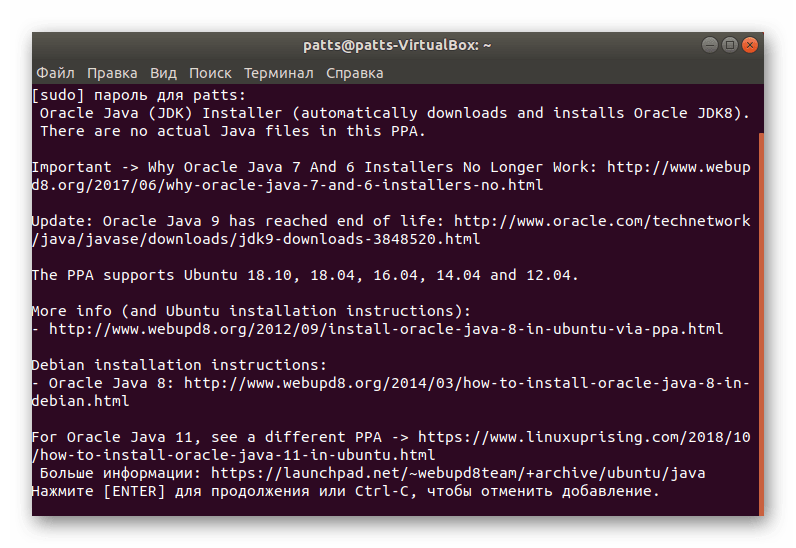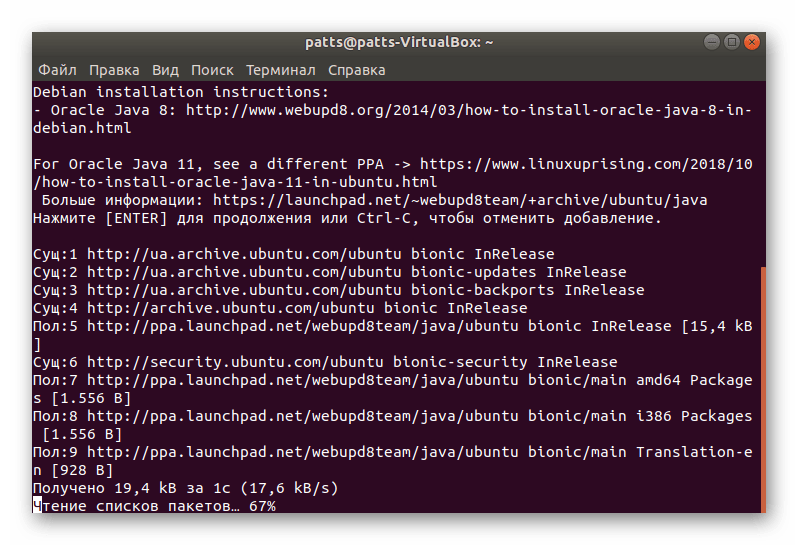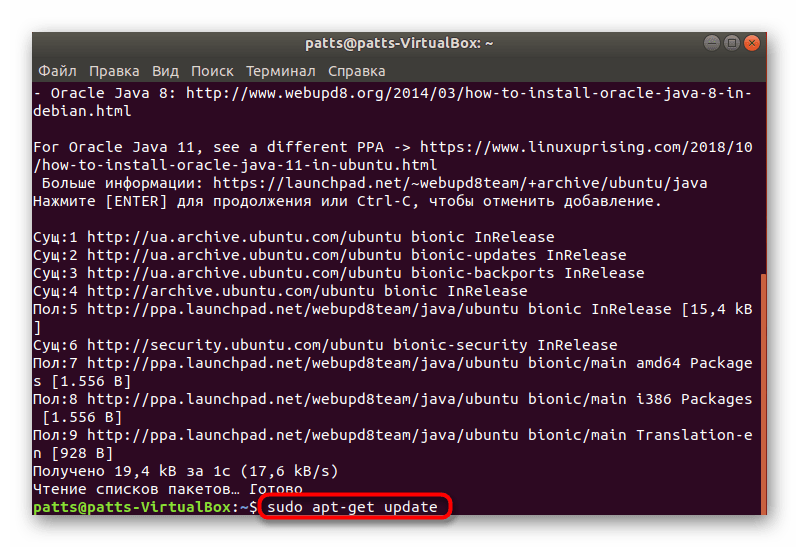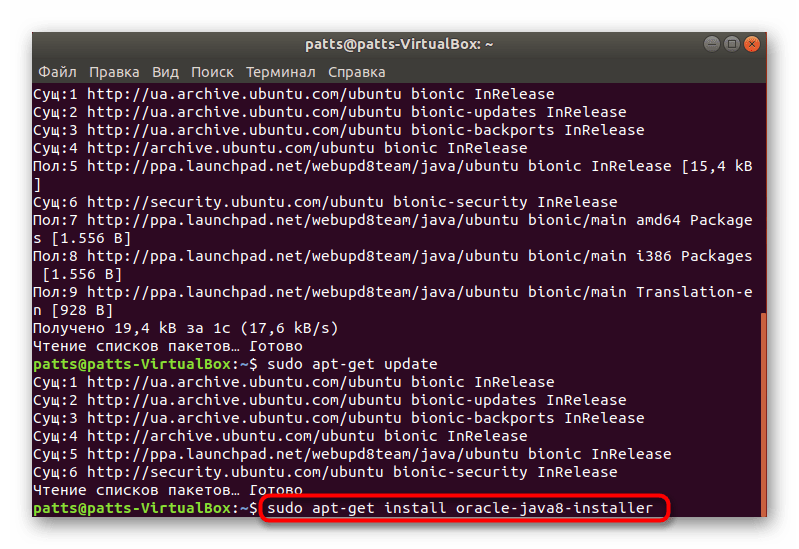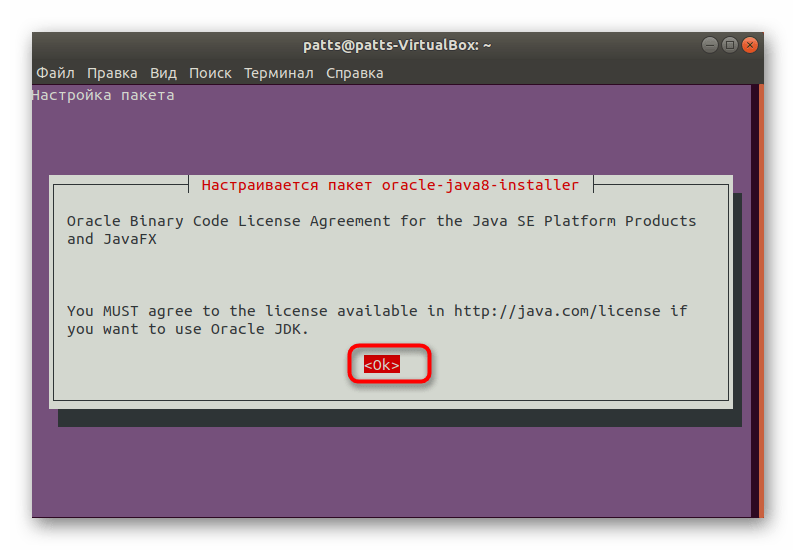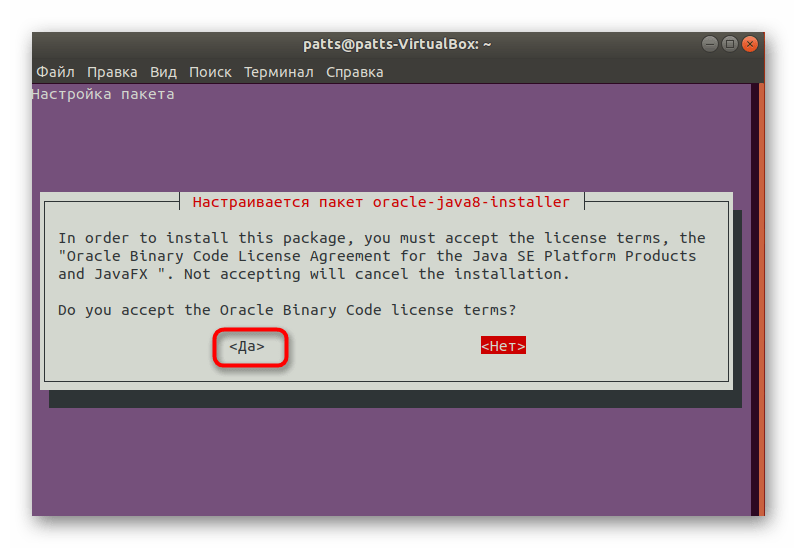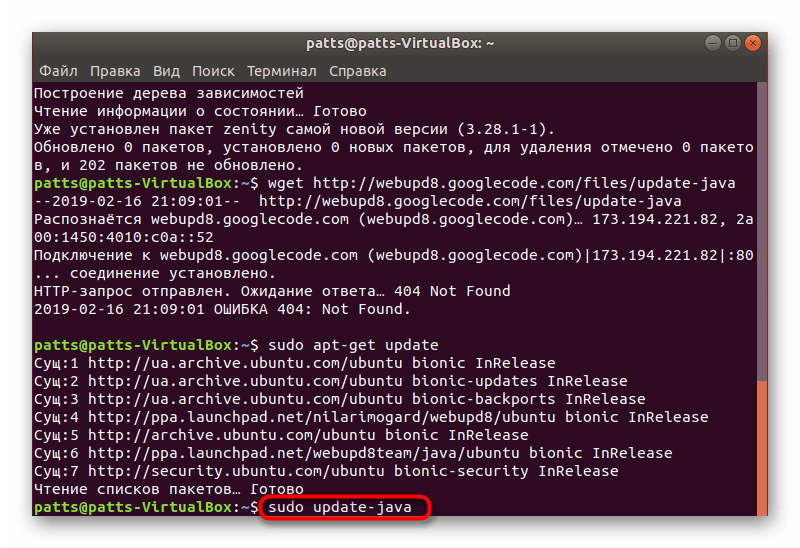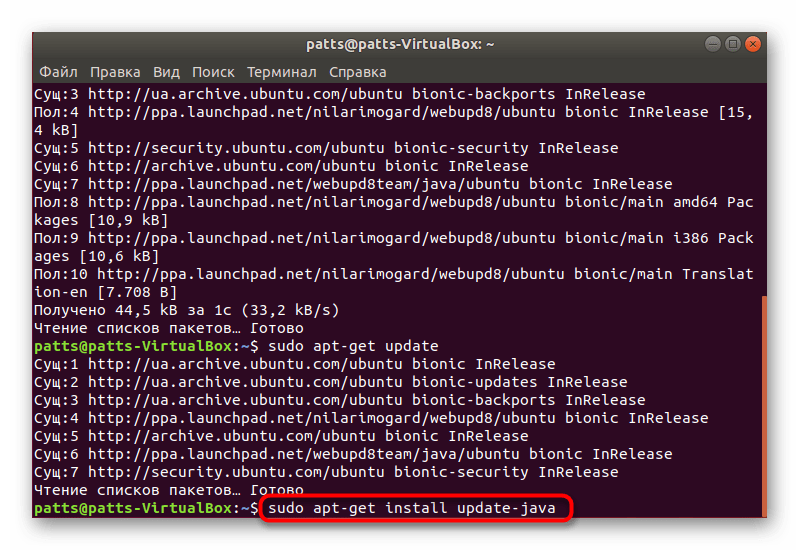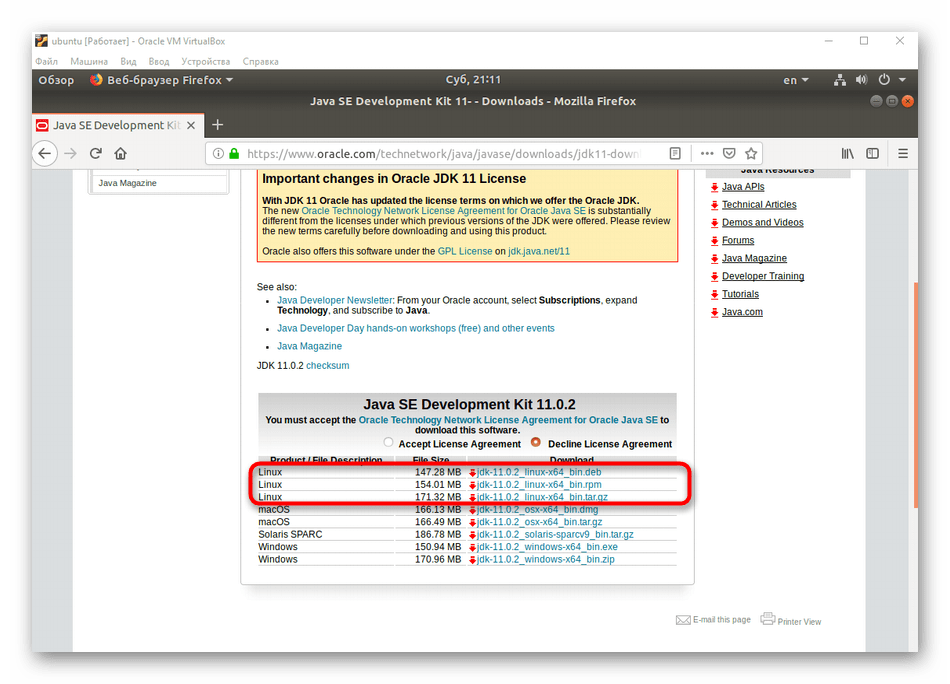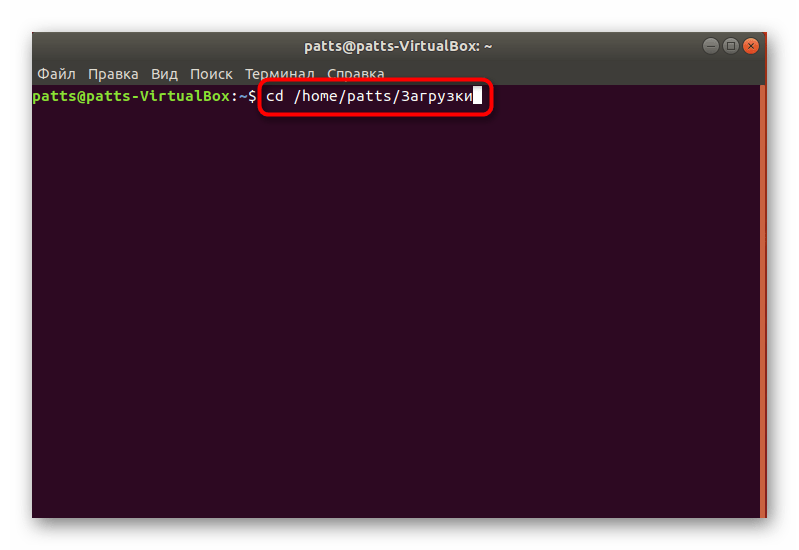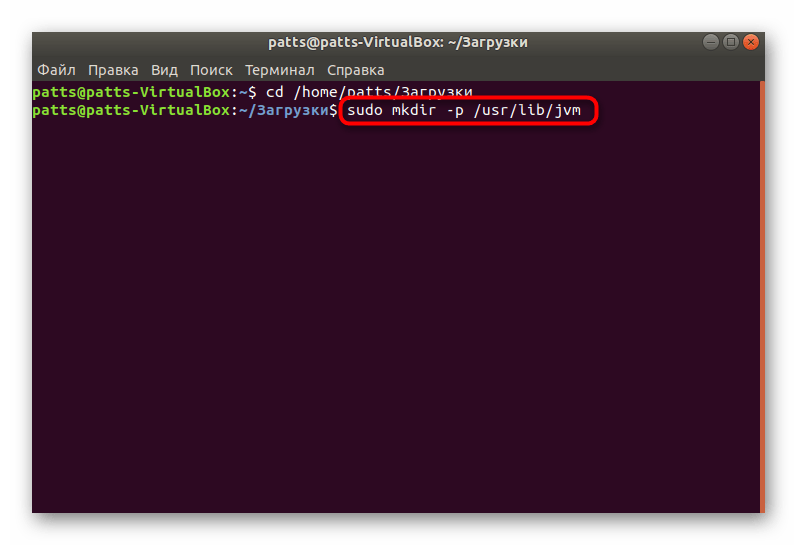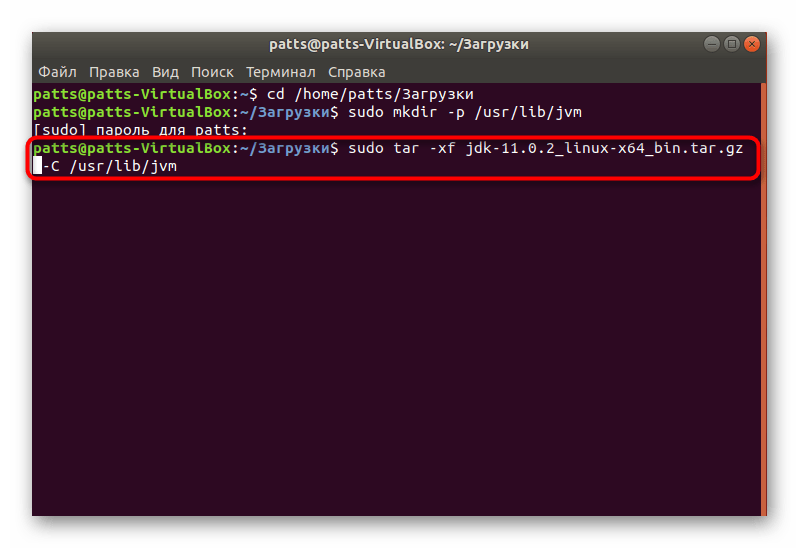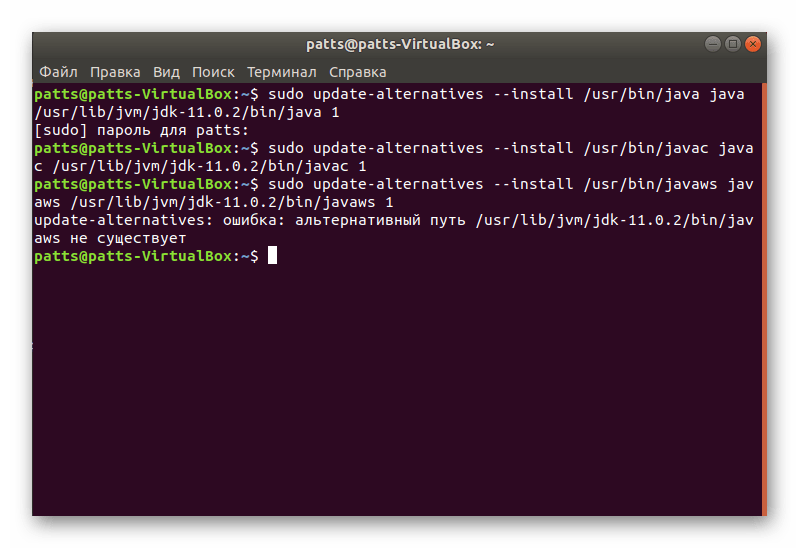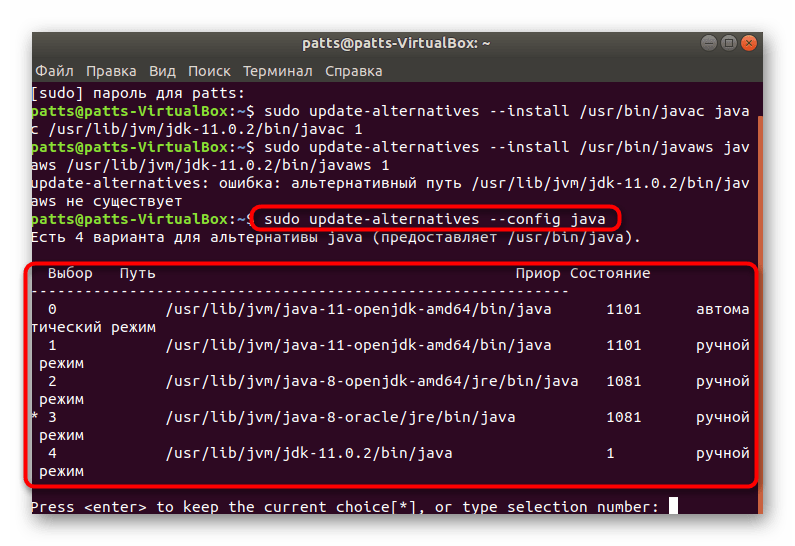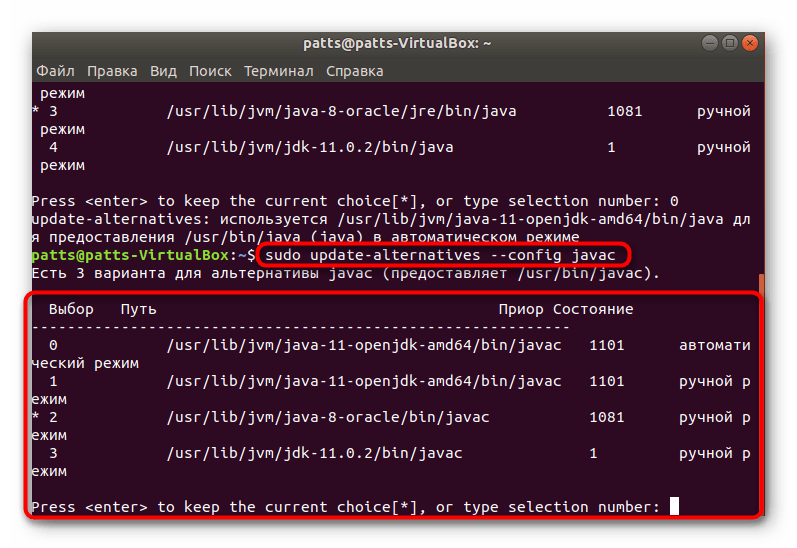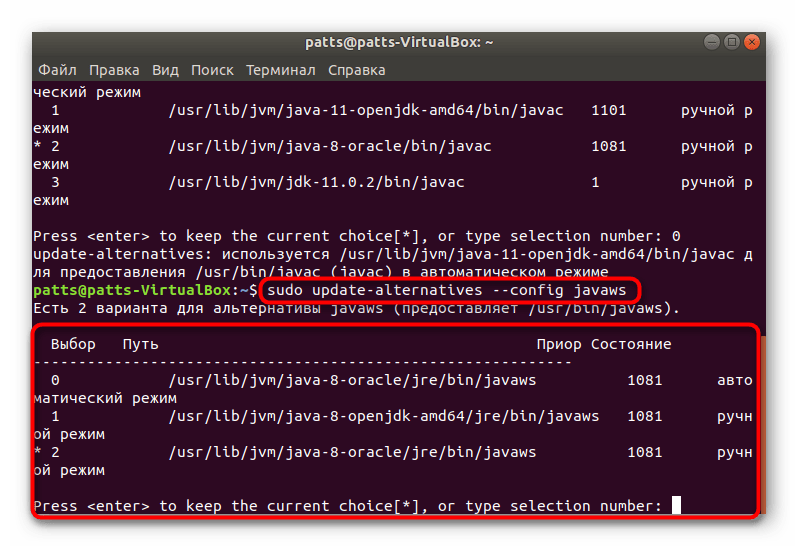- Как вручную установить Oracle Java на Debian или Ubuntu
- Распаковка архива
- Перенос в распакованной папки в /opt
- Установка jdk-9.0.4 и javac в системе по умолчанию
- Проверяем нашу установку
- Установка Java JRE / JDK в Linux
- Устанавливаем Java JRE / JDK в Linux
- Способ 1: Официальные репозитории
- Способ 2: Репозиторий Webupd8
- Способ 3: Обновление с помощью Webupd8
- Способ 4: Ручная установка
- 5 Installation of the JDK and JRE on Linux Platforms
- General Notes About Installing the JDK and JRE on Linux Platforms
- System Requirements for Installing JDK and JRE on Linux Platforms
- JDK and JRE Installation Instruction Notation for Linux Platforms
- Installation of the JDK on Linux from Archive Binaries and RPM Packages
- Installing the 64-Bit JDK 10 on Linux Platforms
- Installing the 64-Bit JDK on RPM-Based Linux Platforms
- Installation of the JRE on Linux from Archive Binaries and RPM Packages
- Installing the 64-Bit JRE 10 on Linux Platforms
- Installing the 64-Bit JRE 10 on RPM-Based Linux Platforms
Как вручную установить Oracle Java на Debian или Ubuntu
Доброго времени суток всем читающим!
Меня часто спрашивают о том, как же установить JDK на ос Линукс, чаще всего это дистрибутив Ubuntu или же другие дистрибутивы основанные на Debian.
Так же у многих в последнее время возникает проблема с установкой JDK через терминал с помощью apt-get install в связи с разного рода ошибками. Чтобы не мучаться с их устранением можно установить java в ручную, так на мой взгляд и лучше и быстрее.
Не Буду томить давайте приступим.
Первое что мы делаем это качаем архив JDK с Oracle.com, на момент написания статьи версия jdk-9.0.4
И так вот шаги которые мы должны выполнить
1) распаковка скачанного архива
2) перенести распакованную jdk в папку /opt/
3) установить jdk-9.0.4 и javac по умолчанию
Распаковка архива
видим, что в папке Загрузок появилась новая папка jdk-9.0.4
Перенос в распакованной папки в /opt
и так, осталось совсем не много.
Установка jdk-9.0.4 и javac в системе по умолчанию
sudo update-alternatives —install /usr/bin/java java /opt/jdk/jdk-9.0.4/bin/java 100
update-alternatives —install /usr/bin/javac javac /opt/jdk/jdk-9.0.4/bin/javac 100
Проверяем нашу установку
sudo update-alternatives —display java
в окне терминала должно выдать, что-то вроде этого
java — auto mode
link best version is /opt/jdk-9.0.4/bin/java
link currently points to /opt/jdk-9.0.4/bin/java
link java is /usr/bin/java
/opt/jdk-9.0.4/bin/java — priority 100
так же можем проверить версию java командой
Поздравляю! вы установили java на linux в ручную.
Источник
Установка Java JRE / JDK в Linux
Компоненты Java необходимы для запуска множества разнообразных приложений и веб-сайтов, поэтому практически каждый пользователь компьютера сталкивается с надобностью инсталляции этой платформы. Конечно, в разных ОС принцип выполнения поставленной задачи отличается, но у дистрибутивов Linux он всегда примерно один и тот же, а мы бы хотели рассказать как осуществляется установка Java в Ubuntu. Обладателям других сборок нужно будет только повторить приведенные инструкции с учетом синтаксиса системы.
Устанавливаем Java JRE / JDK в Linux
Сегодня мы предлагаем ознакомиться с разными вариантами инсталляции библиотек Java, поскольку все они будут максимально полезны и применимы в определенных ситуациях. Например, если вы не хотите использовать сторонние репозитории или же желаете поставить несколько Джава рядом, тогда нужно задействовать отдельный вариант. Впрочем, давайте детально рассмотрим их все.
Сначала рекомендуется проверить обновления системных хранилищ и узнать текущую версию Java, если она вообще присутствует в ОС. Делается это все через стандартную консоль:
- Откройте меню и запустите «Терминал».
Впишите команду sudo apt-get update .
Введите пароль от вашего аккаунта для получения root-доступа.
Если вы получили уведомление, похожее на указанное ниже, значит, Джава в вашей ОС не имеется.
Способ 1: Официальные репозитории
Самый простой метод — использовать официальное хранилище для загрузки Java, которую туда выгрузили разработчики. От вас требуется прописать всего несколько команд, чтобы добавить все необходимые компоненты.
- Запустите «Терминал» и напишите там sudo apt-get install default-jdk , а затем нажмите на Enter.
Теперь добавьте JRE, введя команду sudo apt-get install default-jre .
Не помешает и плагин для браузера, который добавляется через sudo apt-get install icedtea-plugin .
Если вы заинтересованы в получении документации касаемо добавленных компонентов, загрузите их командой sudo apt-get install default-jdk-doc .
Хоть такой метод достаточно прост, он не подходит для установки самых свежих Джава-библиотек, поскольку они последнее время не выкладываются в официальное хранилище. Именно поэтому мы предлагаем ознакомиться со следующими вариантами инсталляции.
Способ 2: Репозиторий Webupd8
Существует пользовательское хранилище под названием Webupd8, в котором имеется скрипт, сравнивающий текущую версию Java с той, что находится на сайте Oracle. Такой метод инсталляции пригодится тем, кто желает установить сброку новее 8 (последней доступной в репозитории Oracle).
- В консоли введите sudo add-apt-repository ppa:webupd8team/java .
Обязательно укажите свой пароль.
Подтвердите операцию добавления, нажав на Enter.
Ожидайте завершения загрузки файлов, не закрывая «Терминал».
Обновите системное хранилище командой sudo apt-get update .
Теперь следует добавить графический инсталлятор путем ввода sudo apt-get install oracle-java8-installer .
Примите лицензионное соглашение для настройки пакета.
Согласитесь с добавлением новых файлов в систему.
По окончании процесса вам будет доступна команда для инсталляции абсолютно любых версий — sudo apt-get install oracle-java7-installer , где java7 — версия Java. Например, вы можете прописать java9 или java11 .
Избавиться от ненужных инсталляторов поможет команда sudo apt-get remove oracle-java8-installer , где java8 — версия Java.
Способ 3: Обновление с помощью Webupd8
Выше мы рассказали об установке сборок путем использования пользовательского хранилища Webupd8. Благодаря этому же репозиторию можно обновлять версию Джава до самой последней как раз путем скрипта сравнения.
- Повторите первые пять шагов из предыдущей инструкции, если вы еще не сделали эти действия.
- Впишите команду sudo update-java , а затем нажмите на Enter.
Используйте команду sudo apt-get install update-java для установки обновлений в случае их нахождения.
Способ 4: Ручная установка
Пожалуй, этот способ самый тяжелый из тех, которые мы рассмотрели в этой статье, однако он позволит получить необходимую версию Java без использования сторонних репозиториев и других дополнительных компонентов. Для осуществления этой задачи вам понадобится любой доступный браузер и «Терминал».
- Через веб-обозреватель перейдите на официальную страницу Oracle для загрузки Джава, где нажмите на «Download» или выберите любую другую необходимую версию.
Ниже находится несколько пакетов с библиотеками. Мы советуем скачать архив формата tar.gz.
Перейдите в папку с архивом, щелкните по нему ПКМ и выберите «Свойства».
Запомните расположение пакета, поскольку вам придется перейти к нему через консоль.
Запустите «Терминал» и выполните команду cd /home/user/folder , где user — имя пользователя, а folder — название папки хранения архива.
Создайте папку для распаковки архива. Обычно все компоненты помещаются в jvm. Создание директории происходит путем ввода sudo mkdir -p /usr/lib/jvm .
Распакуйте в созданную папку имеющийся архив sudo tar -xf jdk-11.0.2_linux-x64_bin.tar.gz -C /usr/lib/jvm , где jdk-11.0.2_linux-x64_bin.tar.gz — название архива.
Для добавления системных путей вам потребуется последовательно ввести следующие команды:
sudo update-alternatives —install /usr/bin/java java /usr/lib/jvm/jdk1.8.0/bin/java 1
sudo update-alternatives —install /usr/bin/javac javac /usr/lib/jvm/jdk1.8.0/bin/javac 1
sudo update-alternatives —install /usr/bin/javaws javaws /usr/lib/jvm/jdk1.8.0/bin/javaws 1
Один из альтернативных путей может не существовать, что зависит от выбранной версии Java.
Осталось только провести конфигурацию каждого пути. Сначала выполните sudo update-alternatives —config java , отыщите подходящую версию Java, сверьте ее цифру и впишите в консоль.
Повторите то же действие с sudo update-alternatives —config javac .
Затем настройте последний путь через sudo update-alternatives —config javaws .
Как видите, методов инсталляции Java в операционную систему Linux существует достаточно большое количество, поэтому каждый пользователь найдет подходящий вариант. Если вы используете специфический дистрибутив и приведенные способы не работают, внимательно изучите отобразившиеся в консоли ошибки и воспользуйтесь официальными источниками для решения проблемы.
Помимо этой статьи, на сайте еще 12315 инструкций.
Добавьте сайт Lumpics.ru в закладки (CTRL+D) и мы точно еще пригодимся вам.
Отблагодарите автора, поделитесь статьей в социальных сетях.
Источник
5 Installation of the JDK and JRE on Linux Platforms
This topic describes the installation procedures of the JDK and JRE on the Linux platform, along with the system requirements.
General Notes About Installing the JDK and JRE on Linux Platforms
This topic describes general information about installing JDK and JRE 10 on Linux platforms.
Installing the JDK automatically creates a directory called jdk– 10 . interim.update.patch . For the JRE, the software automatically creates a directory called jre– 10 . interim.update.patch .
If you install Java SE Runtime Environment in a specific location such as /usr/jdk (for JDK) or /usr/jre (for JRE), then you must log in with root credentials to gain the necessary permissions. If you do not have root access, then either install the Java SE Runtime Environment into your home directory or a subdirectory for which you have write permissions.
If you install the software in a directory that contains a subdirectory named jdk– 10 . interim.update.patch (for JDK) or jre– 10 . interim.update.patch (for JRE), then the new software overwrites files of the same name in that directory. Ensure that you rename the old directory if it contains files that you would like to keep.
By default, the installation script configures the system such that the backing store for system preferences is created inside the JDK or JRE’s installation directory as applicable. If the JDK or JRE is installed on a network-mounted drive, then the system preferences can be exported for sharing with Java runtime environments on other machines.
System Requirements for Installing JDK and JRE on Linux Platforms
See Oracle JDK Certified Systems Configurations for information about supported platforms, operating systems, and browsers.
JDK and JRE Installation Instruction Notation for Linux Platforms
Instructions for installing either JDK or JRE contains a version notation that represents the Feature, Interim, and Update version information.
For example, if you are installing JDK 10 Interim 0, Update 2, and Patch 1, then the following string represents the name of the bundle:
jdk- 10 . interim.update.patch -linux-x64_bin.tar.gz
Installation of the JDK on Linux from Archive Binaries and RPM Packages
You can install the Java Development Kit (JDK) on a Linux platform from archive binary files or from Red Hat Package Manager (RPM) packages.
Installation can be performed by using one of the following processes:
From archive binaries ( .tar.gz ): This allows you to install a private version of the JDK for the current user into any location, without affecting other JDK installations. However, it may involve manual steps to get some of the features to work. See the following table for the options available for downloading and installing the JDK from archive binaries.
From RPM packages ( .rpm ): This allows you to perform a systemwide installation of the JDK for all users, and requires root access. RPM-based Linux platforms are based on Red Hat and SuSE. See the following table for the options available for downloading and installing the JDK from RPM packages.
When you download and install the JDK, the associated Java Runtime Environment (JRE) is also installed.
The following table lists the options and instructions for downloading and installing the JDK 10 release on a Linux platform:
| Download File | Instructions | Architecture | Who Can Install |
|---|---|---|---|
| jdk- 10 . interim.update.patch -linux-x64.tar.gz | Installing the 64-Bit JDK 10 on Linux Platforms | 64-bit | Anyone |
| jdk- 10 . interim.update.patch -linux-x64.rpm | Installing the 64-Bit JDK on RPM-Based Linux Platforms | 64-bit RPM-based Linux | Root |
Installing the 64-Bit JDK 10 on Linux Platforms
You can install the JDK for 64-bit Linux, from an archive binary file ( .tar.gz ).
- Download the file, jdk- 10 . interim.update.patch _linux-x64_bin.tar.gz .
Before you download a file, you must accept the license agreement. The archive binary can be installed by anyone (not only by root users) in any location that you can write to.
The .tar.gz archive file (also called a tarball) is a file that can be simultaneously uncompressed and extracted in one step.
$ tar zxvf jdk- 10 . interim.update.patch _linux-x64_bin.tar.gz
The Java Development Kit files are installed in a directory called jdk- 10 . interim.update.patch in the current directory.
Installing the 64-Bit JDK on RPM-Based Linux Platforms
You can install the JDK on 64-bit RPM-based Linux platforms, such as Red Hat and SuSE, by using an RPM binary file ( .rpm ) in the system location.
- Download the file, jdk- 10 . interim.update.patch _linux-x64_bin.rpm .
Before you download a file, you must accept the license agreement.
$ rpm -ivh jdk- 10 . interim.update.patch _linux-x64_bin.rpm
JDK 10 can coexist with earlier versions of JDK. For each version, a new directory is created, the default directory being /usr/java/jdk. interim.update.patch .
Upgrade the package using the following command:
$ rpm -Uvh jdk- 10 . interim.update.patch _linux-x64_bin.rpm
The JDK installation is integrated with the alternatives framework. After installation, the alternatives framework is updated to reflect the binaries from the recently installed JDK. Java commands such as java , javac , javadoc , and javap can be called from the command line.
Using the java -version command, users can confirm the default (recently installed) JDK version.
In addition, users can check which specific RPM package provides the .java files:
Installation of the JRE on Linux from Archive Binaries and RPM Packages
You can install the Java Runtime Environment (JRE) on a Linux platform from archive binary files or from RPM packages.
Use one of the following processes to install JRE:
From archive binaries ( .tar.gz ): This allows you to install a private version of the JRE for the current user into any location, without affecting other JRE installations. However, it may involve manual steps to get some of the features to work. See the following table for the options available for downloading and installing the JRE from archive binaries.
From RPM packages ( .tar.gz ): This allows you to perform a systemwide installation of the JRE for all users using root access. RPM-based Linux platforms are based on Red Hat and SuSE. See the following table for the options available for downloading and installing the JRE from RPM packages.
When you download and install the Java Development Kit (JDK), the associated JRE is also installed.
The following table lists the options and instructions for downloading and installing the JRE on a Linux platform.
| Download File | Instructions | Architecture | Who Can Install |
|---|---|---|---|
| jre- 10 . interim.update.patch _linux-x64_bin.tar.gz | Installing the 64-Bit JRE 10 on Linux Platforms | 64-bit | Anyone |
| jre- 10 . interim.update.patch _linux-x64_bin.rpm | Installing the 64-Bit JRE 10 on RPM-Based Linux Platforms | 64-bit | Anyone |
Installing the 64-Bit JRE 10 on Linux Platforms
You can install JRE 10 on a 64-bit Linux platform from an archive binary file ( .tar.gz ).
- Download the file, jre- 10 . interim.update.patch _linux-x64_bin.tar.gz .
Before downloading a file, you must accept the license agreement. The archive binary can be installed by anyone (not only root users) in any location that you can write to.
The .tar.gz archive file (also called a tarball) is a file that can be simultaneously uncompressed and extracted in one step.
$ tar zxvf jre- 10 . interim.update.patch _linux-x64_bin.tar.gz
The Java Development Kit files are installed in a directory called jre- 10 . interim.update.patch .
Installing the 64-Bit JRE 10 on RPM-Based Linux Platforms
You can install JRE 10 on 64-bit RPM-based Linux platforms, such as Red Hat and SuSE, using an RPM binary file ( .rpm ) in the system location.
- Download the file, jre- 10 . interim.update.patch _linux-x64_bin.rpm .
Before you download a file, you must accept the license agreement.
$ rpm -e package_name
$ rpm -ivh jre- 10 . interim.update.patch _linux-x64_bin.rpm
Upgrade a package using the following command:
Источник

